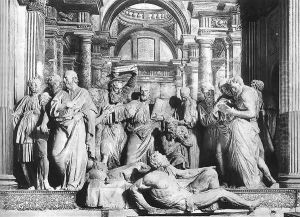Alfonso Lombardi Paintings
Alfonso Lombardi, born in Ferrara, Italy, in 1497, was an illustrious Italian sculptor of the Renaissance period, known for his intricate terracotta sculptures and works in marble. His contributions to art are often celebrated for their intricate details, emotional depth, and innovative techniques that marked a significant departure from the more rigid and formulaic styles of the earlier periods. Lombardi's body of work, though not as extensively documented as some of his contemporaries, played a crucial role in the evolution of Italian Renaissance sculpture, particularly in the domain of religious and mythological subjects.
Lombardi's early life is shrouded in mystery, but it is known that he was active in Bologna from about 1517 until his death in 1537. His most notable works include the Lamentation over the Dead Christ, a remarkable terracotta group created for the church of Santa Maria della Vita in Bologna. This work, characterized by its dynamic composition and the emotional intensity of the figures, is considered a masterpiece of Italian Renaissance sculpture, showcasing Lombardi's skill in capturing human emotion and his innovative use of terracotta as a medium.
Another significant contribution of Lombardi is his work on the relief decorations for the Basilica of San Petronio in Bologna, where his narrative reliefs demonstrate a keen eye for storytelling through sculpture. His ability to imbue his sculptures with a sense of movement and life set a new standard for the depiction of biblical and historical scenes in art.
Despite his premature death at the age of 40 in 1537, Lombardi's legacy lived on through his contributions to the Renaissance art movement. His innovative approach to sculpture, particularly his use of terracotta, influenced many of his contemporaries and successors. Lombardi's work is a testament to the transformative power of the Italian Renaissance, reflecting the era's values of humanism, exploration of human emotion, and the pursuit of beauty in art. His sculptures remain celebrated for their technical mastery, emotional depth, and their significant role in the evolution of Renaissance sculpture.
